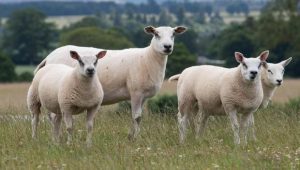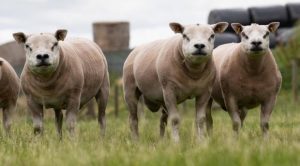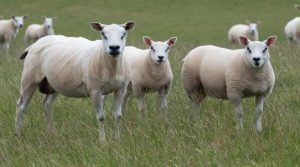Producing top quality stock is very much a family affair for the Rattrays from West Park, Auchterarder, who believe they have found the ideal in the Beltex.
David and Jean Rattray, sons Michael and Paul and daughter, Sarah farm 250 acres at West Park, which, with the addition of 750 acres of annual and seasonal agreements from local farms enables them to run 900 ewes and 100 suckler cows.
“We run 900 cross ewes comprising a mixture of Scotch Mules, Texel cross and Beltex cross ewes and a few pure-bred Texel and Beltex ewes to breed tups for our own use and to sell privately,” said David.
It’s the Beltex that breeds the best for Michael and Paul who attend to most of the sheep work, as it produces the best finished lambs and some cracking good females too.
“The Beltex appeals to our system as they are easy lambed and quick to get to their feet. Beltex cross females also make great mothers – producing a good quality lamb which always attracts a premium when sold through the live ring,” said Michael.

With that in mind, the family look to purchase top quality sires at the premier sales at Carlisle and at Kelso, with some of best performing Beltex in the past having been bought from the Tercrosset and Ochtermuthill flocks.
“We do use our own Beltex and Texel tups but we try to buy a few in each year to introduce new blood. We always look for stock tups to be good on their legs with a tight skin and hard muscle,” said Michael.
Paul added: “Beltex tups are certainly great workers. We bought a tup from the Whitefords at Tercrosset, which ran with 70 Texel cross gimmers and he got them all in lamb, resulting in a scanning percentage of 220%.”
Overall scanning percentages work out at 203% across the ewes and the hoggs, whilst the pure Beltex ewes scan at 180-185%.
The breeding flock at West Park is based on bought in Scotch Mule gimmers purchased every year from Ewen Cheape, Glenfarg, which in turn are tupped to a Texel of which the best 100 Texel cross females are retained for breeding purposes. These are then tupped with the Beltex or Beltex cross, resulting in a quality fat lamb with great carcase and conformation.
“We find this cross produces an ideal prime lamb that is easily finished off grass,” said David.
“Contrary to popular opinion, Beltex lambs do grow well on grass alone and most of the time they can compete with other continental breeds when crossed with the correct ewe. Last year – for the first time – we tupped the bigger end of the Texel cross Mule hoggs with a Charollais cross Beltex which proved a huge success, as they were easy lambed and the hoggs were great mothers with plenty milk,” he added.

After scanning, ewes are split up depending on how many lambs they are carrying. Single-bearing ewes are moved onto older grass and receive mineral buckets up until a week prior to lambing, when they are then fed a mixture of silage and Harbro ewe rolls.
Ewes carrying twins are fed silage and mineral buckets until four weeks before lambing, when they then introduced to an additional 400g of ewe rolls, per day. Ewes bearing triplets and quads receive silage, mineral buckets and ewe rolls eight weeks prior to lambing.
“We start feeding the triplets and quads around 400g per day, increasing to 800g over two feeds, four weeks before lambing,” Michael commented.
“Once the ewes are inside we also feed molasses, which we find really helps to reduce twin lamb disease,” he added.
Lambing at West Park, kicks off on March 25 and during this busy spell, family friend, Lucy Christie, helps out during the night for three weeks, whilst daughter, Sarah and Michael’s wife, Jen, take time off work to assist.
As well as family members lending a hand, now retired farm worker, Mike Whyte – who joined West Park in 2001 – helps the Rattrays on a part time basis during the intensive lambing and calving periods.
While most of the flock is lambed inside, limited shed space means that 200 of the second and third-crop ewes have to be lambed outside. Inside, ewes and their new born lambs are put into individual pens as they lamb, for approximately 24 hours, with lambs rung and scratched for orf before heading out to the field – depending on the weather. Lambs have their navels sprayed with iodine at birth and again at a day old.

“We have almost eliminated watery mouth and joint ill by spraying the lambs navels twice and by bedding the individual pens with pine shavings instead of straw which keeps the lambs drier and cleaner,” said Paul.
All the triplet and quad lambs receive artificial colostrum at birth and for the first 24 hours with the weakest lambs taken off the ewe and put on to a Volac milk feeder which this year looked after 200 lambs.
“Since we purchased the Volac feeder, we no longer have to twin lambs onto ewes that have singles meaning that we can get ewes out of the shed quickly with just the one lamb which will finish at 12-15 weeks of age,” David added.
Lambs are weaned at the end of July and sold fat, with the majority being sold through the live ring at United Auctions, Stirling, with a handful sold deadweight through Scotbeef at Bridge of Allan. The bulk are finished off grass and are away by the end of October, with typical prices ranging between £80 and £90 per head, and the Beltex lambs attracting a premium.
Any smaller and well-shaped lambs are kept on the farm through until January and are finished with the addition of Harbro pellets.
“Last year our top price for the Beltex lambs was £120, or £3 per kg, however, this year, we sold our first batch of lambs straight off their mothers at 12-weeks-old through United Auctions and they averaged £116 at 47kg, whilst our Beltex crosses topped at £126,” David commented.
Whilst running a busy beef and sheep farm all year round, the Rattrays make time to attend and support their local agricultural shows and they have certainly made their mark over the years.
“We show at Braco and Perth, with highlights including champion commercial at Braco with three Beltex cross gimmers and reserve champion at Perth with three Beltex prime lambs,” Paul stated.
“We have also won the Young Farmers section, at Perth Show, with the Beltex cross lambs.”
Commenting on the future of the industry and the Beltex breed, David concluded: “We are happy knowing that we are doing the job to the best of our ability. Margins are getting tighter and the Beltex lamb always commands a premium in the market place – the future of the breed looks to be very bright.
“We are not concerned about the future of the industry as people will always need food. The consumer is becoming more aware of the importance of the origin and quality of food which is a great thing for us farmers.”
Thanks to The Scottish Farmer.

